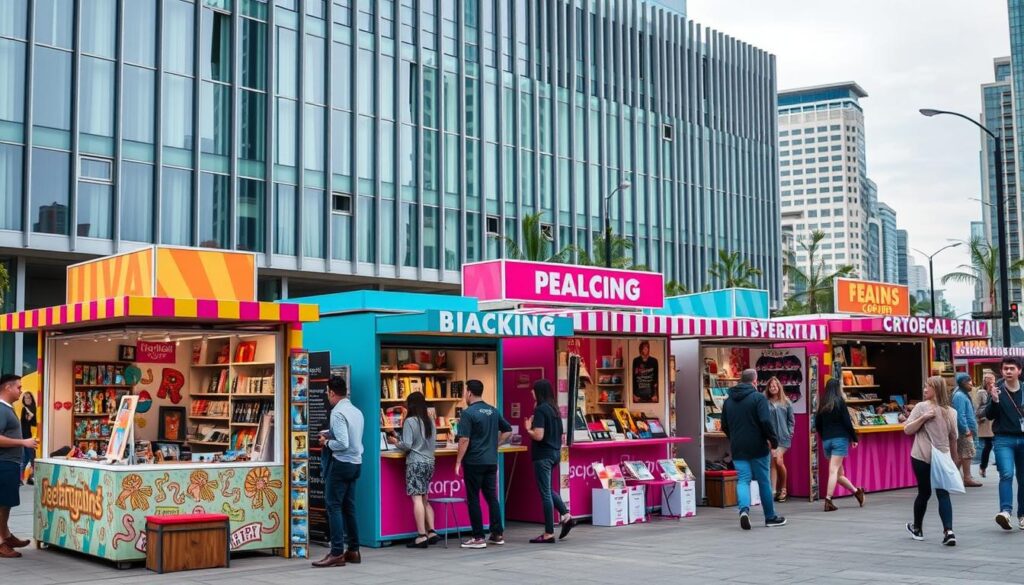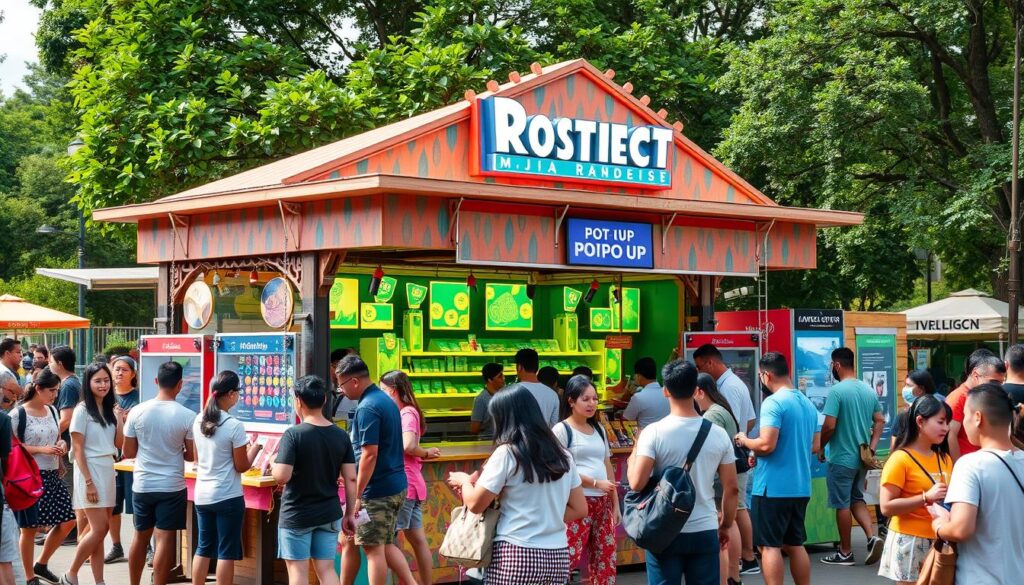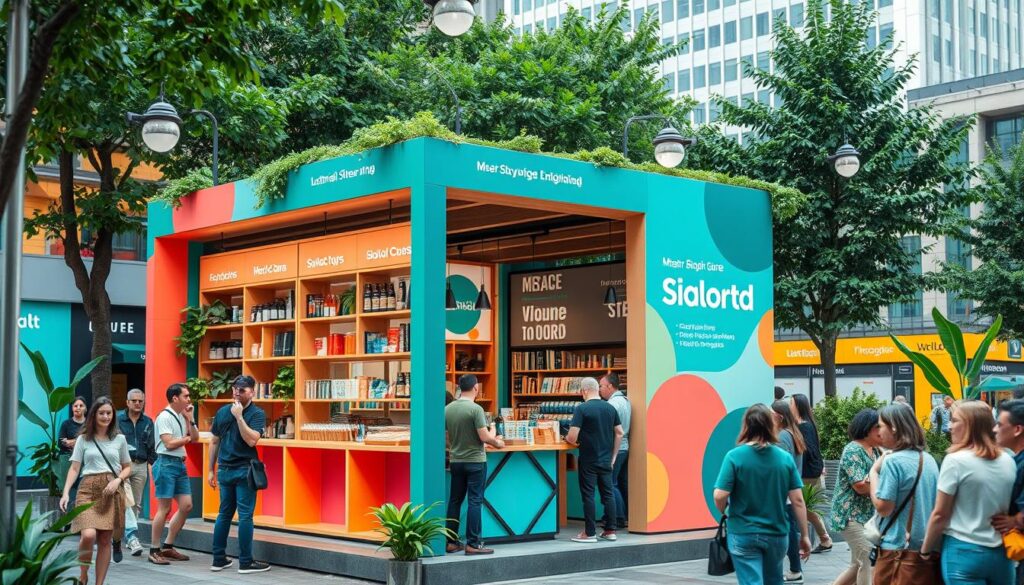Pop-up kiosks are changing the retail world. They let brands quickly adapt to what customers want. These temporary spots help brands get noticed and connect with people in new ways.
The rise of online shopping has made things tough for stores. The pandemic made it even harder. But pop-up retail kiosks offer a flexible and affordable way to introduce new products and create excitement.
These kiosks use cool tech like augmented reality. This makes them more than just temporary spots. They could be the start of something big.

Key Takeaways
- Pop-up kiosks provide flexibility and a cost-effective retail strategy for brands.
- They foster deeper customer engagement through unique shopping experiences.
- The “fear-of-missing-out” drives traffic and creates buzz around these temporary setups.
- Innovative technologies enhance the immersive experience offered by pop-up kiosks.
- Pop-ups can evolve into permanent retail spaces, showing their true value.
Understanding the Pop-Up Kiosk Phenomenon
Pop-up kiosks are a big deal in retail today. They are temporary and fun. Brands use them to offer unique experiences to shoppers. These kiosks let brands test new markets and quickly change with trends.
What is a Pop-Up Kiosk? Defining Characteristics and Advantages
A pop-up kiosk is a mobile sales spot that pops up anywhere. You might see them in malls or at festivals. They aim to grab attention with cool displays and events. Unlike regular stores, they cost less and don’t tie you down for long.
Why the Surge in Popularity? Exploring the Drivers Behind the Trend
Pop-up kiosks are becoming more popular because of changes in retail and how people shop. Many empty stores in cities are being used for short-term plans. These shops offer unique experiences, which people love. Plus, the chance to get something before it’s gone brings people in.
Benefits for Brands: Flexibility, Cost-Effectiveness, and Targeted Reach
Brands get a lot from pop-up kiosks. They can try out new ideas without big risks. They’re cheaper to run than regular stores, which means more profit. These kiosks also help brands reach certain groups, like young people who like real experiences. Big companies use them to get noticed and connect with customers.
Strategic Advantages of Pop-Up Kiosks
Pop-up kiosks are great for brands wanting to innovate and connect with people. They offer unique retail experiences that engage customers and save money. Here are ways brands can use pop-up kiosks to meet their goals.
Testing New Markets and Concepts: Minimizing Risk and Gathering Valuable Data
Pop-up kiosks are perfect for testing markets. They let brands see how customers react without the big costs of permanent stores. By collecting data and getting feedback, companies can check if new products or ideas work.
These temporary spots help businesses adjust quickly. They can improve their plans and make things better before expanding.
Creating Buzz and Excitement: Generating Hype and Driving Foot Traffic
The short life of pop-up kiosks makes them exciting. They create a rush to visit and try things out. With well-planned events and ads, brands can make a big splash.
This buzz can lead to more people coming in. When customers share their fun times online, it helps the brand get noticed even more.
Building Brand Awareness and Customer Engagement: Direct Interaction and Personalized Experiences
Pop-up kiosks help brands talk directly to customers. This boosts awareness and engagement. By making experiences personal, companies can make a strong impression.
An immersive setting shows off products well and connects with people on an emotional level. Brands that focus on these interactions can build loyalty and get more customers back.
Launching New Products or Collections: Showcasing Innovation and Generating Early Sales
Pop-up kiosks are the best for introducing new items. They create excitement and kickstart sales with cool displays and hands-on experiences. Brands can show off new stuff and get feedback from customers.
This helps refine products and builds anticipation for more. It’s a smart way to introduce new things and see how they do.

Key Considerations for Pop-Up Kiosk Success
Success in pop-up kiosks depends on several key factors. These include choosing the right location and effective branding. Each factor is important for creating a great experience for customers. By understanding and using these considerations, you can improve the customer experience and boost sales.
Location, Location, Location: Choosing the Right Spot for Your Target Audience
Finding the perfect location is essential for pop-up kiosk success. You need to pick spots with lots of foot traffic to reach your audience. High-traffic areas mean more people see your kiosk, leading to more engagement.
Make sure the location fits your product and audience. Setting up at local events or festivals can also increase visibility and attract more people.
Kiosk Design and Branding: Creating a Visually Appealing and Memorable Experience
The design and branding of your kiosk should be eye-catching and consistent. A well-designed kiosk grabs attention and encourages people to explore. Unique branding makes your kiosk stand out and builds a strong brand identity.
A memorable design not only attracts customers but also encourages positive word-of-mouth. This leads to more visits and a loyal customer base.
Product Selection and Merchandising: Curating a Compelling Offer
Choosing the right products is a key part of your pop-up kiosk strategy. You need to understand what customers want and what’s trending. Good merchandising, like attractive displays, can encourage people to buy on impulse.
Keep your kiosk organized and focused. Avoid clutter. A clear and easy-to-follow display helps customers navigate and find what they need.
Staffing and Customer Service: Providing Excellent Support and Building Relationships
Having knowledgeable staff is vital for great customer service. They can answer questions, offer personalized experiences, and build relationships. Proper training helps staff handle different situations well.
This improves the customer experience and builds loyalty to your brand.

| Consideration | Description | Impact on Success |
|---|---|---|
| Location Selection | Strategic spot analysis based on foot traffic and target audience alignment | Higher visibility and engagement levels |
| Kiosk Design | Creating a visually appealing layout that reflects brand identity | Enhanced customer interest and memorable interactions |
| Product Selection | Curation of compelling offerings based on consumer preferences | Increased impulse purchases and customer satisfaction |
| Staffing | Well-trained staff providing excellent customer service | Improved customer relationships and brand loyalty |
Pop-Up Kiosk Ideas for Different Industries
Pop-up kiosks are great for many industries. They let brands connect with customers in new ways. Each field can use these temporary shops to get people excited, sell more, and build their brand.
Fashion and Apparel: Showcasing New Collections and Exclusive Items
Fashion pop-ups are perfect for showing off new clothes and special items. Brands can make limited editions to draw in shoppers looking for something unique. Seasonal themes or team-ups can make the experience even better, bringing more people to stores.
Food and Beverage: Introducing New Products and Creating Unique Culinary Experiences
Food pop-ups are great for introducing new foods and creating culinary experiences. Brands can let customers try new things, which gets them excited. Themed food pop-ups not only sell more but also give people fun dining experiences to talk about.
Technology and Gadgets: Demonstrating New Devices and Hands-On Trials
Tech pop-ups let people try out new gadgets and see how they work. This builds trust and helps people decide to buy. Showing off the latest tech in a hands-on way can really get people interested, leading to more sales and loyalty.
Health and Beauty: Providing Samples, Mini-Treatments, and Personalized Consultations
Health and beauty pop-ups offer a chance to try out products and get mini-treatments. They let brands show how their products work and connect with customers. This leads to better experiences and loyal customers.
| Industry | Pop-Up Strategy | Key Benefits |
|---|---|---|
| Fashion and Apparel | Showcasing new collections, exclusive items | Heightened visibility, urgency in purchases |
| Food and Beverage | Product introductions, culinary experiences | Memorable experiences, increased sales |
| Technology | Device demonstrations, hands-on trials | Improved consumer trust, informed decision-making |
| Health and Beauty | Samples, mini-treatments, personalized consultations | Stronger connections, brand loyalty |
Measuring the Success of Your Pop-Up Kiosk
To really know how well a pop-up kiosk is doing, brands need to look at different key performance indicators (KPIs). These KPIs show how successful the pop-up is in engaging customers, increasing brand awareness, and boosting sales. This information is key to figuring out what’s working and what needs tweaking.
Key Performance Indicators (KPIs): Tracking Sales, Customer Engagement, and Brand Awareness
It’s important to set up strong KPIs to measure a pop-up kiosk’s success. Looking at store visits and how often people come back can tell you a lot about brand awareness and customer interest. For example, comparing sign-ups to actual visits can show how well the kiosk attracts people.
Gathering Customer Feedback: Surveys, Social Media Monitoring, and Direct Interactions
Getting feedback from customers is key to making a pop-up experience better. Surveys and social media monitoring help brands talk to customers and learn important insights. Watching for mentions and hashtags on platforms like Instagram and Twitter can give a better understanding of online engagement. Talking directly to customers also provides immediate feedback, helping to improve future pop-ups and increase customer happiness.
Analyzing Data and Making Adjustments: Optimizing Your Strategy for Future Pop-Ups
Looking at data is essential for improving future pop-ups. By studying customer engagement metrics like how long people stay and how often they visit, brands can make smart changes. Using insights from customer data helps tailor the experience to what customers want. This not only makes the current pop-up better but also sets a good base for future ones.
Conclusion
Pop-up kiosks have changed the retail world, giving brands a chance to grow. These temporary shops offer new ways to shop and connect with customers. They challenge old ways of shopping and make experiences that people remember.
By using pop-up shops, businesses can stand out in a crowded market. They can improve how they connect with customers and make their brand known. This is key for success in today’s fast-changing world.
Experiential marketing is key for brands to succeed in many fields. It helps them reach new people and boost their image. For example, IKEA’s Tiny Home tour and Nike’s pop-up shops show how well this works.
Starting a pop-up shop can be affordable, with prices as low as $50 a day. This lets brands try new things without big costs. It’s a way to test ideas and see what works.
Pop-up kiosks offer a chance for brands to be creative and connect with people. Using these shops can lead to lasting growth and success. It creates experiences that customers will remember, even after the shop is gone.
By embracing pop-up shops, brands can make a big impact in the changing retail world. It’s a way to stand out and connect with customers in new and exciting ways.
FAQ
What are pop-up kiosks, and how do they function in the retail space?
Pop-up kiosks are temporary stands that offer unique experiences to shoppers. They let brands connect with customers in new ways. This approach is flexible and helps brands build strong relationships with their audience.
Why has there been a surge in the popularity of pop-up kiosks?
Pop-up kiosks have become popular because of changing shopping habits. With more stores closing, brands see them as a chance to try new things. They offer unique experiences and let brands test ideas without big risks.
What are the strategic advantages of using pop-up kiosks?
Pop-up kiosks are great because they’re flexible and cost-effective. They help brands test markets and get feedback. They also create excitement and draw more people in with fun experiences.
How do brands measure the success of a pop-up kiosk?
Brands track success by looking at sales, engagement, and awareness. They also listen to what customers say. This helps them see what works and improve their next pop-up.
What types of products or services work well in pop-up kiosk environments?
Many industries do well with pop-up kiosks. Fashion, food, tech, and beauty are examples. Fashion shows off new items, while food offers samples and creates buzz.
How important is location for a successful pop-up kiosk?
Location is key for a pop-up kiosk. Brands need to pick places where their customers are. This ensures they get seen and attract more people.
What role does kiosk design play in attracting customers?
Good design and branding draw in customers. A nice look makes people curious. Unique branding leaves a lasting impression, encouraging repeat visits.
How can brands gather customer feedback during a pop-up activation?
Brands can get feedback through surveys, social media, and direct talks. This feedback helps them understand what customers like. It lets them improve the experience for everyone.